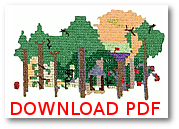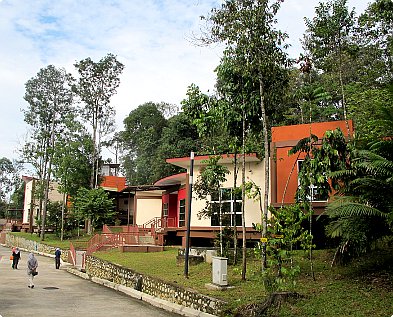EX-SITU CONSERVATION: MOTIVATING STUDENTS FOR SCIENCE THROUGH COLLABORATIVE LEARNING
28th February 2013
This seminar with secondary teachers and environemental actors organized by Prof. Dr. Nor Aini Ab Shukor (Universiti Putra Malaysia) aimed to investigate the potential of a web platform for tree mapping and naming like pericopsis.org to increase students’ motivation for science learning. The gathering held at Sultan Idris Shah Forest Education Centre (SISFEC) Ayer Hitam Forest was supported by MarComm, INTROP and the Faculty of Forestry.
Introduction
This initiative is in line with the strategies 2020 defined in the Malaysia’s national policy on biological diversity (NBP) namely with the following aspects:
- “Promote and encourage the understanding and participation of the public and Institutions for the effective conservation and protection of biological diversity” (strategy NBP12);
- “Incorporate the study of biological diversity and related fields into the curricula
of schools and institutions of higher learning” (strategy NBP 12.3).
The objective was to discuss with teachers and environmental actors the possibilities of increasing student’s motivation and social responsibility by publishing knowledge produced during
learning processes in a collaborative information program for the study and conservation of tree diversity.
The proposed approach was presented to an audience of 30 persons including UPM lecturers and researchers, biology and agriculture teachers from 3 Malaysian secondary schools and one international school.
Were also present different environmental actors namely the Sepang Local Council, Shah Alam MBSA, FRIM, Subang Jaya Local Council, Landscape Malaysia, Institute of Forestry and environmental Science.
First presentation
"Developing ex-situ conservation for a socially embedded biodiversity management of endangered tree species"

The presentation highlighted the importance of ex-situ tree conservation in urban environment and described the design web platform based on “open data” and web 2.0 technologies for collaborative tree management. A model of socially embedded tree conservation was presented using the example of the dipterocarpaceae family.
Following discussion
The environmental actors present at the meeting agreed with the pertinence of involving the public in tree conservation activities. They mentioned their own programs and ongoing actions in relation with the public and approved the possibility of publishing part of their data as “open source” on the experimental pericopsis.org website. The current option of displaying tree data in “i-frames” on the participants own websites by downloading KML files has been mentioned. Future developments permitting to display real time data were evoked and envisaged. Some current limitations of the use of endangered trees such as dipterocarpaceae or other local forest trees in urban environments were evoked. Indeed, plantation of these species is not adapted for all urban environments and knowledge about their survival in modified environment is lacking. Subang Jaya local council is planning to establish small pockets of planted forest islands for the purpose of dynamic ex-situ conservation that could be favorably made available for collaborative projects. Environmental actor presents at the meeting will be held informed about further development and contacted within this year for possible collaborations.
Second presentation
"Engaging students in environmental problems solving through Web 2.0 supported collaborative learning activities"

After introducing the concept of “web 2.0 supported cooperative learning”, the perspective to collaborate with the public, schools or different environmental actors for tree conservation was presented as a possible way to increase student’s motivations for self-learning. Concordances of these approaches with current curriculum contents and suggested learning methods were highlighted. An example of learning sequence using functions of the pericopsis.org platform was presented and future developments discussed.
Following discussion
Teachers showed interest for publishing students work on pericopsis.org but some assistance would be needed for the identification of school trees or the definition of a simplified identification key.
A different approach could be that students would describe different parts of the trees (branches, leaves, bark…) using the vocabulary of a guide. In absence of identification, students could for example send a “description card” with targeted photographs to a botanist for species determination.
Interested teachers were welcomed to publish their teaching experience in order to share ideas with their colleagues. In case of success, their teaching models could be proposed to other schools in Malaysia or other countries.
With future improvements of the pericopsis.org platform functions, it should become possible to build a collective and simplified identification method using photographs and guided descriptions uploaded by students from different schools.
Future functions should also permit to publish information able to guide students in ex-situ conservation initiatives (publication of species lists in nature reserves, inventories…) within their school or in association with other environmental actors.
It has been noticed that in case of success the model of tree naming and mapping by students will reach a limit when all trees within a school will be mapped. New models of integrating students learning processes into real science projects will then need to be defined. Most suitable models should be those requiring repeated measurements on a yearly basis.
Teachers and environmental actors expressed unanimous willingness to support conservation of local tree species. This demonstrates the potential of future collaboration between schools, universities and environmental actors (local councils, NGO…).
Interested environmental actors were invited to publish open data on pericopsis.org. Subang Jaya Local Council suggested the organization of a seminar on how to support awareness on tree conservation and management at different levels in the society.
Questionnaire
The following questions were answered by the teachers:
Afternoon program

The afternoon program was a hands-on session on the use and discovery of the pericopsis.org platform for tree naming and mapping. After a few instructions on how to register the name and to record a polygon on the map, most of the participants were able to enter new trees.
Future actions
Interested teachers and environmental actors will be contacted individually in the coming months to discuss possibilities of further collaborations. Successful initiatives and improvements of the web services will be published. If opportune, a next meeting will be organized in 2014.
